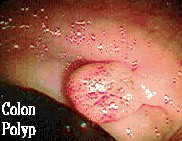 |
Unfortunately, the early stages of this disease
are usually asymptomatic. This makes it difficult to detect the disease
at the stage when there is the most hope for survival. This makes regular
screening a necessity.
In some patients, adenomatous colon polyps may form. Contrary to its name, Hereditary Non-polyposis Colon Cancer is associated with polyp formation. However, these polyps form at similar rate in the general public, making it an inconclusive symptom. (Ref. 8) HNPCC's name is meant to reflect that the rate of polyp formation is not abnormal. This separates HNPCC from another inheritable colon cancer, Familiar Adenomatous Polyposis (FAP) which is characterized by hundreds of polyps carpeting the large intestine. |
The most important warning sign for this disease is the occurrence of HNPCC in family members. Because the gene is autosomal dominant, if one person in the family is known to carry the mutation, there is a good chance that they are not alone. It is advisable for people to investigate the occurrence of HNPCC in their families and provide their doctor with an accurate account of their findings.
|